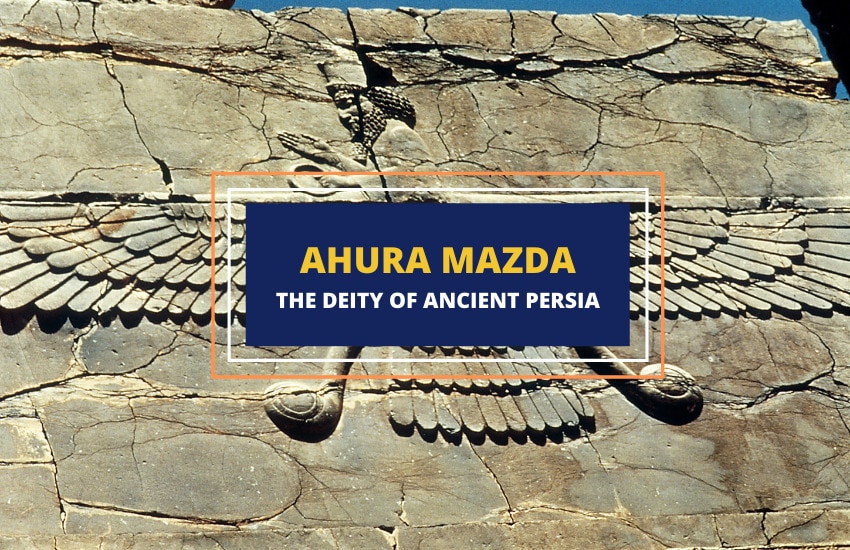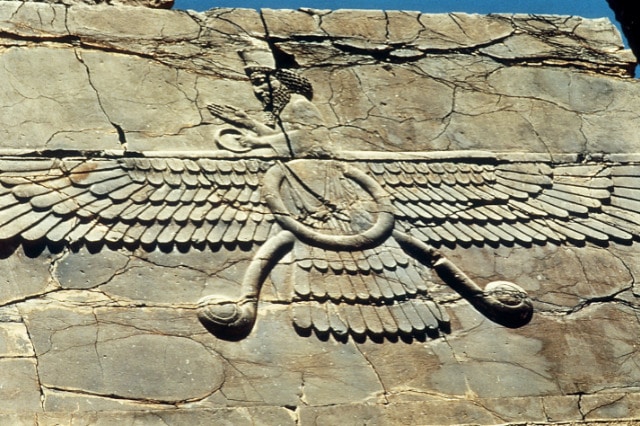
Table of Contents
The god of light and wisdom, Ahura Mazda is the principal deity of Zoroastrianism, the ancient Iranian religion which influenced the world before Greece became a major power. In fact, it shaped one of the most complex empires of the ancient world—the Persian Empire – and its influence can be felt in the West as well.
Here’s what to know about the Zoroastrian god and the significance of this deity in ancient Persia.
Who Was Ahura Mazda?
Ahura Mazda, also called Oromasdes, Ohrmazd, and Hurmuz, was the main deity in the Indo-Iranian religion which predated Zoroastrianism. This religion was polytheistic and consisted of several deities, each with their own domain of power. However, Ahura Mazda was the principal god and was followed by the rest.
According to Zoroastrian tradition, the prophet Zoroaster, also known as Zarathustra in Avestan, received a vision from Ahura Mazda while partaking in a pagan purification ritual. He believed that Ahura Mazda created the universe as the supreme god. In some accounts, he was warned of an upcoming war, and taught some principles that would lead to the religion known as Zoroastrianism.
Most of what is known about Zoroaster comes from the Zoroastrian scripture Avesta, also called Zend-Avesta. The prophet is thought to have been born in what is now southwestern Afghanistan or northwestern Iran around 6th century BCE, though some archeological evidence points to earlier times, between 1500 and 1200 BCE.
Zoroastrianism would change the way religion was practiced in the region, focusing on a single god and essentially turning the nation into monotheism, what was then a radical concept. Accordingly, Ahura Mazda was the one true god who had not been worshipped properly till then. All the other gods of the Iranian pagan religion were only aspects of Ahura Mazda, not deities in and of themselves.
Characteristics of Ahura Mazda

The name Ahura Mazda was derived from the Sanskrit word medhās, that means wisdom or intelligence hence it translates as Wise Lord. During the Achaemenid period, he became known as Auramazda, but the name Hormazd was used during the Parthian period and Ohrmazd during the Sassanian period.
In Zoroastrian belief, Ahura Mazda is the creator of life, the supreme god in heaven, and the source of all goodness and happiness. He’s also regarded as the god of wisdom and light. He has no equal, is changeless, and was not created. He created the two spirits – Angra Mainyu, the destructive force, and Spenta Menyu, the beneficial force and aspect of Ahura Mazda himself.
In the Avesta, the sacred text of Zoroastrianism, fire is referred to as the son of Ahura Mazda, and Zoroastrian writings also contain prayers to fire. It’s a misconception that the Zoroastrians worship fire; rather, fire is a symbol of god and represents Ahura Mazda.
In a way, fire serves as symbol of Ahura Mazda, as it provides light. Zoroastrian places of worship are even called fire temples. Each temple featured an altar with an eternal flame that burned continuously and thought to have come directly from Ahura Mazda at the beginning of time.
Ahura Mazda and the Persian Empire
Zoroastrianism was the state religion of three Persian dynasties—Achaemenid, Parthian, and Sassanian— until the Muslim conquest of Persia in the 7th century CE. The history of Persian kings, particularly their moral behavior as rulers, reveals their beliefs in Ahura Mazda and the teachings of Zoroaster.
The Achaemenid Empire
Lasting around 559 to 331 BCE, the Achaemenid Empire was founded by Cyrus the Great. It surrounded the areas of modern-day Iran, Turkey, Egypt, and parts of Pakistan and Afghanistan. There’s no evidence that the Persian king embraced the teachings of Zoroaster, but he still ruled by the Zoroastrian law of asha—the concept of truth and righteousness. Unlike other emperors, Cyrus showed mercy toward the people of the kingdoms he conquered, and he didn’t impose Zoroastrianism them.
By the time of Darius I, around 522 to 486 BCE, Zoroastrianism became significant to the empire. In an inscription on a cliff at Naqsh-e Rustam, near Persepolis, Ahura Mazda was referred to as the creator of the heavens, earth, and humanity. The inscription was written by the king, and was recorded in three languages, including Babylonian or Akkadian, Elamite and Old Persian. It shows that Darius I attributed his success to the Zoroastrian god who gave the strength of his kingdom and of his reign.
The Achaemenid Empire began to decline under the reign of Darius’s son, Xerxes I. He followed his father’s faith in Ahura Mazda, but had less understanding of the details of Zoroastrianism. Even though the Zoroastrians believed in free will, he established Zoroastrianism at the expense of all other religions. In the epic poem Shahnameh, he’s described as a religious king with missionary zeal.
Artaxerxes I who reigned around 465 to 425 BCE also worshipped Ahura Mazda, but probably approved the union of Zoroastrianism with older polytheistic teachings. By the time of Artaxerxes II Mnemon, Ahura Mazda may have figured in a triad, as the king invoked the protection of the Zoroastrian god, as well as Mithra and Anahita. He even reconstructed the Hall of Columns at Susa for the three gods.
Alexander the Great Conquered Persia
For more than two centuries, the Achaemenid Empire ruled the Mediterranean world, but Alexander the Great conquered Persia in 334 BCE. As a result, the beliefs in Ahura Mazda in the empire weakened, and Zoroastrianism was almost totally submerged by the Hellenistic religion.
In fact, the capital city of Susa featured the coinage of Seleucid period without the Zoroastrian god. Under the rule of Greek Seleucids, Zoroastrianism reappeared through the empire, but it flourished along the cults of foreign gods.
The Parthian Empire
By the Parthian, or the Arsacid, period in 247 BCE to 224 CE, Zoroastrianism gradually emerged. In the 1st century BCE, names of Iranian gods were merged with Greek names, such as Zeus Oromazdes and Apollo Mithra.
Eventually, Zoroastrianism was embraced by the empire and its rulers. In fact, many of the temples destroyed during the times of Alexander the Great were rebuilt. Ahura Mazda remained worshipped, along with deities Anahita and Mithra.
Parthian rulers were more tolerant, as other religions including Hinduism, Buddhism, Judaism and Christianity were present in the empire. By the end of the Parthian period, Ahura Mazda was depicted as a male figure standing—or sometimes on horseback.
Sassanian Empire
Also called Sasanid, the Sassanian Empire was founded by Ardashir I who reigned in 224 to 241 CE. He made Zoroastrianism the state religion, and as a result, the followers of other religions faced persecution. He was credited, along with his priest Tansar, for establishing a unified doctrine. The king appears as a sage in the Zoroastrian tradition.
However, another form of Zoroastrianism, known as Zurvanism, emerged during the Sasanid period. During the reign of Shapur I, Zurvan became the supreme god, while Ahura Mazda was only regarded as his son. By the time of Bahram II, Ahura Mazda was given the title Ohrmazd-mowbad. Under Shapur II, the Avesta was assembled, as the manuscripts of the original were also destroyed at the conquest.
The Muslim Conquest of Persia
Between 633 and 651 CE, Persia was conquered by Muslim intruders, which led to the rise of Islam. Zoroastrians were persecuted and discriminated against. The invaders charged Zoroastrians extra taxes for retaining their religious practices. As a result, most Zoroastrians converted to Islam, while others fled tos rural areas of Iran.
From the 10th century onward, some Zoroastrians escaped religious persecution by fleeing to India, where they continued the worship of Ahura Mazda. These escapees became known as Parsi, whose name means Persians. Experts speculate that they landed in Gujarat, a state in western India, around 785 to 936 CE.
Zoroastrianism survived in small communities in Iran, but by the 11th and 13th centuries the Turkish and Mongol invasions forced them to withdraw to the mountain regions of Yazd and Kerman.
Ahura Mazda in Modern Times
Ahura Mazda remains significant in Zoroastrianism and Persian mythology. As with many mythological figures, the Zoroastrian god has an impact on contemporary popular culture in the West.
In Religion
Pilgrimage serves to remember Ahura Mazda, as well as to celebrate an ancient festival. The Pir-e Sabz, also known as Chak-Chak, is the most visited pilgrimage site located inside a cave. Other places include Seti Pir in Maryamabad, Pir-e Naraki in Mehriz, and Pir-e Narestaneh in the Kharuna mountains.
In parts of Iran, Zoroastrianism is still practiced as a minority religion. In Yazd, there’s a fire temple known as the Ateshkadeh, which is a popular tourist attraction. In Abarkuh, there exists a 4,500-year-old cypress tree that’s believed to have been planted by Zoroaster.
In Pakistan and India, Ahura Mazda is worshipped by the Parsi, which is also an ethnic minority in their region. Some of these Parsi also immigrated to other parts of the world, including America, Australia, and Britain.
In Literature and Pop Culture
Freddie Mercury, the famous singer of Queen, came from a Parsi family and was Zoroastrian by birth. He was proud of his heritage and famously declared to an interviewer,“I’ll always walk around like a Persian popinjay and no one’s gonna stop me, honey!”
The Japanese automobile brand Mazda (which means wisdom) was named after the deity Ahura Mazda.
In Europe, many became familiar with Ahura Mazda and his prophet Zoroaster though the 19th-century philosophical novel Thus Spoke Zarathustra by Friedrich Nietzsche. It’s a work of philosophy that centers on the concepts of ubermensch, the will to power, and eternal recurrence.
Ahura Mazda also has also been featured in comic books, including Wonder Woman and Dawn: Lucifer’s Halo by Joseph Michael Linsner. He is also the inspiration behind the legend of Azor Ahai in George R.R. Martin’s A Song of Ice and Fire, which was later adapted into the series Game of Thrones.
FAQs About Ahura Mazda
Ahura Mazda is symbolized by a male figure. He’s typically depicted standing or riding on horseback in a dignified manner.
Angra Mainyu is the destructive spirit, the evil force that fights Ahura Mazda, who represents light and goodness.
He is the creator of the universe, the source of all that’s good and joyful, and a compassionate, kind, and just being.
Yes, the company confirmed that the name was inspired by the ancient Persian deity. However, some have also said that it was inspired by the founder Matsuda.
In Brief
Ahura Mazda is the supreme god in Zoroastrianism, which became the state religion of Persia. He was the revered god of Achaemenid kings, especially Darius I and Xerxes I. However, the Muslim invasion led to the decline of the religion in Iran and many Zoroastrians escaped to India. Today, Ahura Mazda remains significant to modern day Zoroastrians, making it one of the oldest religions still in existence.








